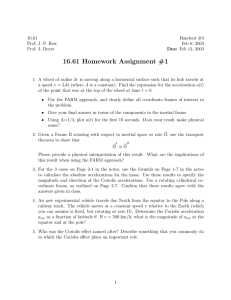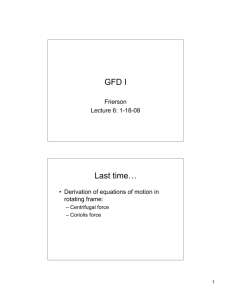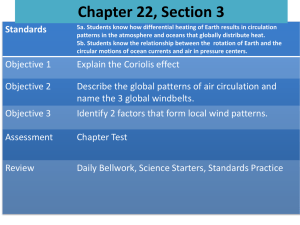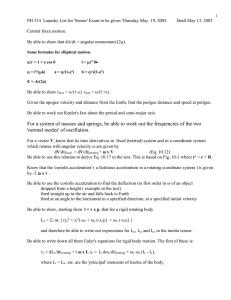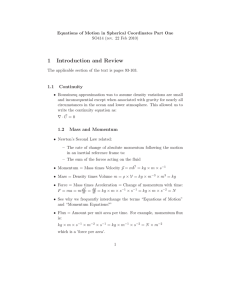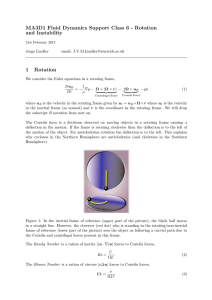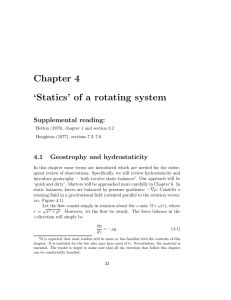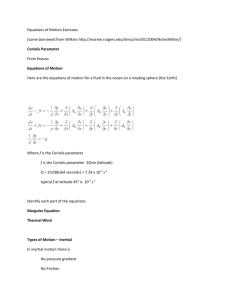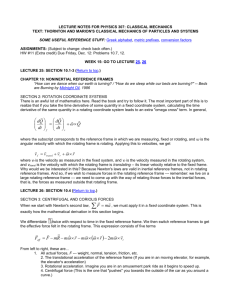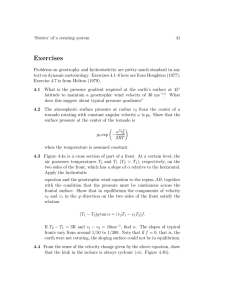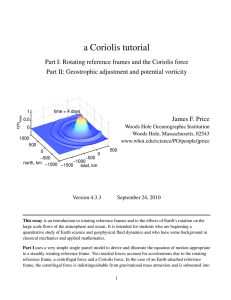Document 13659736
advertisement
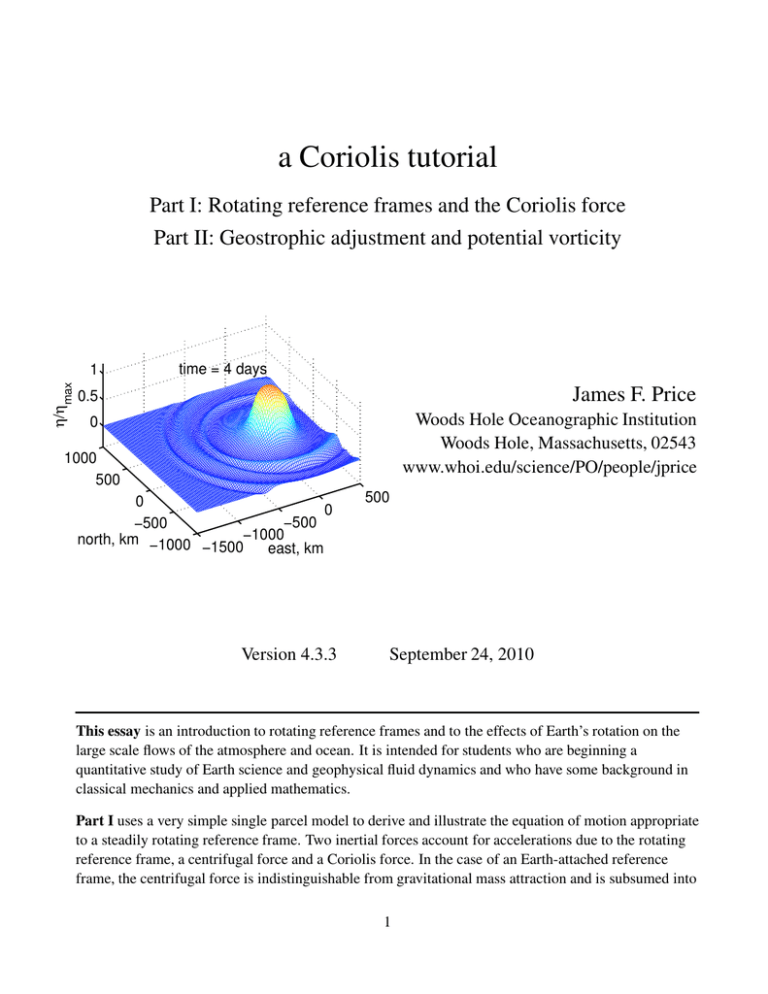
a Coriolis tutorial Part I: Rotating reference frames and the Coriolis force Part II: Geostrophic adjustment and potential vorticity η/η max 1 time = 4 days 0.5 James F. Price 0 Woods Hole Oceanographic Institution Woods Hole, Massachusetts, 02543 www.whoi.edu/science/PO/people/jprice 1000 500 0 0 −500 −500 −1000 north, km −1000 −1500 east, km Version 4.3.3 500 September 24, 2010 This essay is an introduction to rotating reference frames and to the effects of Earth’s rotation on the large scale flows of the atmosphere and ocean. It is intended for students who are beginning a quantitative study of Earth science and geophysical fluid dynamics and who have some background in classical mechanics and applied mathematics. Part I uses a very simple single parcel model to derive and illustrate the equation of motion appropriate to a steadily rotating reference frame. Two inertial forces account for accelerations due to the rotating reference frame, a centrifugal force and a Coriolis force. In the case of an Earth-attached reference frame, the centrifugal force is indistinguishable from gravitational mass attraction and is subsumed into 1 the gravity field. The Coriolis force has a very simple mathematical form, −2Ω × V� M, where Ω is Earth’s rotation vector, V� is the velocity observed from the rotating frame and M is the parcel mass. The Coriolis force is perpendicular to the velocity and so tends to change velocity direction, but not velocity amplitude, i.e., the Coriolis force does no work. If the Coriolis force is the only force acting on a moving parcel, then the velocity vector of the parcel will be continually deflected anti-cyclonically. These free motions, often termed inertial oscillations, are a first approximation of the upper ocean currents that are generated by a transient wind event. If the Coriolis force is balanced by a steady force, say a pressure gradient, then the resulting wind or current will be in a direction that is perpendicular to the pressure gradient force. An approximate geostrophic momentum balance of this kind is the defining characteristic of the large scale, low frequency circulation of the atmosphere and oceans outside of the tropics. Part II uses a single-layer fluid model to solve several problems in geostrophic adjustment; a one- or two-dimensional mass anomaly is released from rest and allowed to evolve under gravity and rotation. The fast time scale response includes gravity waves with phase speed C that tend to spread the mass anomaly. If the anomaly has a horizontal scale that exceeds several times the radius of deformation, Rd = C/f, where f = 2Ω sin (latitude) is the Coriolis parameter, then the Coriolis force will arrest the spreading and yield a quasi-steady, geostrophic balance. An exact geostrophic balance would be exactly steady, while it is evident that the atmosphere and the ocean evolve continually. Departures from exact geostrophy can arise in many ways including as a consequence of frictional drag with a boundary, and from the latitudinal variation of f. The latter beta-effect imposes a marked anisotropy onto the atmosphere and the ocean — eddies and long waves propagate phase westward and the major ocean gyres are strongly compressed onto the western sides of ocean basins. These and other low frequency phenomenon are often best interpreted as a consequence of potential vorticity conservation, the geophysical fluid equivalent of angular momentum conservation. Earth’s rotation contributes planetary vorticity = f, that is generally considerably larger than the relative vorticity of winds and currents. Small changes in the latitude or thickness of a fluid column may convert planetary vorticity to relative vorticity, � × V� , succinctly accounting for some of the most important large scale, low frequency phenomena, e.g., westward propagation. 2 Contents 1 Large-scale flows of the atmosphere and ocean. 1.1 Classical mechanics observed from a rotating Earth . . . . . . . . . . . . . . . . . . . . 1.2 The goal and the plan of this essay . . . . . . . . . . . . . . . . . . . . . . . . . . . . . 1.3 About this essay . . . . . . . . . . . . . . . . . . . . . . . . . . . . . . . . . . . . . . . 4 9 11 13 2 Part I: Rotating reference frames and the Coriolis force. 2.1 Kinematics of a linearly accelerating reference frame . . . . . . . . 2.2 Kinematics of a rotating reference frame . . . . . . . . . . . . . . . 2.2.1 Transforming the position, velocity and acceleration vectors 2.2.2 Stationary ⇒ Inertial; Rotating ⇒ Earth-Attached . . . . . 2.2.3 Remarks on the transformed equation of motion . . . . . . . . . . . . 14 14 17 17 23 25 . . . . . . . . 27 28 30 30 31 33 34 35 37 . . . . . . . . 38 38 39 40 41 42 44 44 48 A dense parcel on a slope. 5.1 Inertial and geostrophic motion . . . . . . . . . . . . . . . . . . . . . . . . . . . . . . . 50 52 3 4 5 Inertial and noninertial descriptions of elementary motions. 3.1 Switching sides . . . . . . . . . . . . . . . . . . . . . . . . . 3.2 To get a feel for the Coriolis force . . . . . . . . . . . . . . . 3.2.1 Zero relative velocity . . . . . . . . . . . . . . . . . . 3.2.2 With relative velocity . . . . . . . . . . . . . . . . . . 3.3 An elementary projectile problem . . . . . . . . . . . . . . . 3.3.1 From the inertial frame . . . . . . . . . . . . . . . . . 3.3.2 From the rotating frame . . . . . . . . . . . . . . . . 3.4 Appendix to Section 3: Circular motion and polar coordinates. A reference frame attached to the rotating Earth. 4.1 Cancelation of the centrifugal force . . . . . . . . . . . . . 4.1.1 Earth’s (slightly chubby) figure . . . . . . . . . . . 4.1.2 Vertical and level in an accelerating reference frame 4.1.3 The equation of motion for an Earth-attached frame . 4.2 Coriolis force on motions in a thin, spherical shell . . . . . . 4.3 Why do we insist on the rotating frame equations? . . . . . 4.3.1 Inertial oscillations from an inertial frame . . . . . . 4.3.2 Inertial oscillations from the rotating frame . . . . . 3 . . . . . . . . . . . . . . . . . . . . . . . . . . . . . . . . . . . . . . . . . . . . . . . . . . . . . . . . . . . . . . . . . . . . . . . . . . . . . . . . . . . . . . . . . . . . . . . . . . . . . . . . . . . . . . . . . . . . . . . . . . . . . . . . . . . . . . . . . . . . . . . . . . . . . . . . . . . . . . . . . . . . . . . . . . . . . . . . . . . . . . . . . . . . . . . . . . . . . . . . . . . . . . . . . . . . . . . . . . . . . . . . . . . . . . . . . . . . . . . . . . . . . . . . . . . . . . . . . . . . . . . . . . 1 LARGE-SCALE FLOWS OF THE ATMOSPHERE AND OCEAN. 5.2 6 7 4 Energy budget . . . . . . . . . . . . . . . . . . . . . . . . . . . . . . . . . . . . . . . . Part II: Geostrophic adjustment and potential vorticity. 6.1 The shallow water model . . . . . . . . . . . . . . . 6.2 Solving and diagnosing the shallow water system . . 6.2.1 Energy balance . . . . . . . . . . . . . . . . 6.2.2 Potential vorticity balance . . . . . . . . . . 6.3 Linearized shallow water equations . . . . . . . . . . . . . . . . . . . . . . . . . . . . . . Models of the Coriolis parameter. 7.1 Case 1, f = 0, nonrotating . . . . . . . . . . . . . . . . . . 7.2 Case 2, f = constant, an f-plane, . . . . . . . . . . . . . 7.3 Case 3, f = fo + βy, a β-plane, . . . . . . . . . . . . . . . 7.3.1 Beta-plane phenomena . . . . . . . . . . . . . . . . 7.3.2 Rossby waves; low frequency waves on a beta plane 7.3.3 Modes of potential vorticity conservation . . . . . . 7.3.4 Some of the varieties of Rossby waves . . . . . . . . . . . . . . . . . . . . . . . . . . . . . . . . . . . . . . . . . . . . . . . . . . . . . . . . . . . . . . . . . . . . . . . . . . . . . . . . . . . . . . . . . . . . . . . . . . . . . . . . . . . . . . . . . . . . . . . . . . . . . . . . . . . . . . . . . . . . . . . . . . . . . . . . . . . . . . . . . . . . . . . . . . . . . . . . 55 . . . . . 56 57 59 60 60 64 . . . . . . . 64 65 69 75 76 79 84 86 8 Summary of the essay. 88 9 Supplementary material. 9.1 Matlab and Fortran source code . . . . . . . . . . . . . . . . . . . . . . . . . . . . . . 9.2 Additional animations . . . . . . . . . . . . . . . . . . . . . . . . . . . . . . . . . . . . 90 90 91 MIT OpenCourseWare http://ocw.mit.edu Resource: Online Publication.Fluid Dynamics James Price The following may not correspond to a particular course on MIT OpenCourseWare, but has been provided by the author as an individual learning resource. For information about citing these materials or our Terms of Use, visit: http://ocw.mit.edu/terms.
